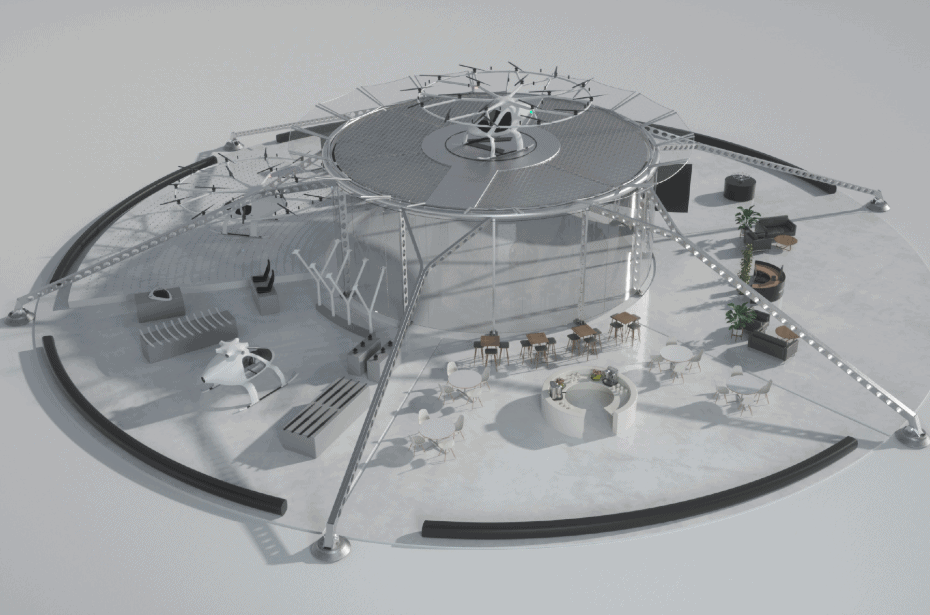eVTOL Skyports: Extending PaxEx Beyond Flights and Airports
Share

An architecture consultancy in the UK has developed a concept for eVTOL skyports – take-off and landing pads for flying taxis – which would function like pop-up airports.
UK-based architectural practice small (Six Miles Across London Ltd.) unveiled its vision for electric vertical take-off and landing (eVTOL) infrastructure at a launch party yesterday in London. The event featured a video presentation, visuals and 3D-printed models showcasing the deployment and operational possibilities of a pop-up eVTOL skyport concept in various scenarios: on a rooftop, in a parking lot, and on an offshore floating installation. Ricky Sandhu, the founder of small, created the design and collaborated with Arup (the engineering consultancy that has developed over a hundred airports) to verify the project’s technical feasibility.
The concept is vehicle agnostic – the infrastructure is designed to accommodate all types of eVTOL craft for transporting passengers or cargo. small (which lists Airbus as a client) is in discussions with a number of airlines to explore how the passenger journey might be extended between home or office and the airport using the concept.
“We are talking to [airlines that] see a market for some of their premium passengers. There are a lot of airlines, particularly in the Middle East, that would like to transport their passengers from home in limos – not just to the airport but directly onto the aircraft – so deploying eVTOLs from fixed or pop-up skyports to transfer passengers from home or office directly to an airliner could be a new line of business for some airlines,” Sandhu said.
He sees the potential to alleviate traffic congestion around airports as one of the main selling points of this new form of autonomous personal air mobility, viewing it as an enhancement to what airlines are doing, rather than any form of competition: “If you look at most airports in big cities, they’re about 30 minutes away from downtown which we think is within the range of most of the eVTOL vehicles currently in development. But it’s important to note that this form of urban air mobility has to complement the large mobility hubs. It doesn’t replace them – it’s the missing link.”
“This form of urban air mobility has to complement the large mobility hubs. It doesn’t replace them – it’s the missing link.” – Ricky Sandhu, founder, small
Aside from the complex regulatory hurdles ahead in terms of certifying eVTOLs for flight, especially above urban environments and particularly in respect to their interface with air traffic in and around airports, according to Sandhu, bringing this mode of connectivity and extending airline passenger experience between airports and anywhere else will require a shift in public perception. “In order for this to be socially accepted at the widest level we think that eVTOL designers not only need to design the infrastructure to support their products but they also need to educate and include the public and explain to them how it works, how sustainable it is, how comfortable it could be and build a whole passenger experience around it,” he said.
The firm’s video (above) illustrates how the pop-up skyport can be delivered by truck, and then erected in different locations. The radial structure supports an elevated landing pad, surrounded by plug-in modules including a check-in area, a store for spare batteries and parts, a maintenance facility, a coffee shop and a bookstore – compact versions of the amenities and facilities that exist at a full scale airport. The idea is that by making all these familiar elements visible to prospective passengers, they will gain confidence in potentially using the concept.
“We are also talking with some of the eVTOL manufacturers who, from what we have seen, have invested heavily and continue to invest in the actual vehicle,” Sandhu said. “But we think there needs to be the same amount of investment in the infrastructure that will allow those vehicles to provide a mobility service because you have to board people, take payment and deal with passengers. You can’t just do that with the vehicle itself, you need to have infrastructure, and so we have invested in posing what that infrastructure might to look like”.


